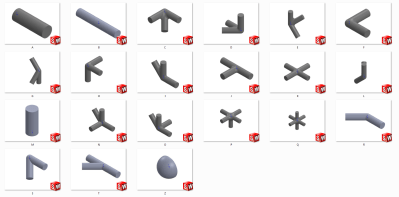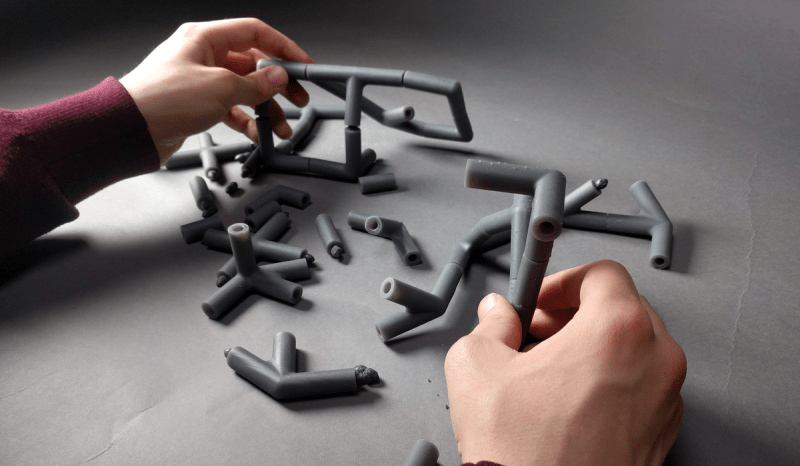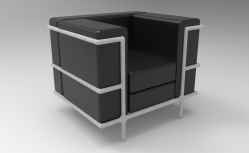The purpose of Geometer becomes apparent when you realize its simplicity: [David Troetschel]’s project is to create an easily understandable design tool that encourages goal-oriented design. The kit comes with physical components and digital counterparts that can be combined in a modular way. They each have a specific geometry, which provide versatility while keeping manufacturing simple.

For the prototyping phase, small snap-on parts 3D printed on a Formlabs printer mimic the module components on a smaller scale. Once a design is conceived and the Geometer Grasshopper program finalizes the module arrangement necessary for the model, the larger pieces can be used as a mold for a concrete or hydrocal mold casting.
The present set of modules is in its seventh iteration, initially beginning as a senior thesis for [Troetschel]. Since then, the project itself has had an extensive prototyping phase in which the components have gone from being injection-molded to 3D printed.
The overall process for prototyping is faster than 3D printing and more cost-effective than sending to a third-party shop to build, which adds to the project’s goal of making manufacturing design more accessible. This is an interesting initiative to introduce a new way of making to the DIY community, and we’re curious to see this idea take off in makerspaces.






















Looks as if it could be adapted to models and molecules and assorted protein structures with a number of added standard angles of intersection and even a part where you can choose the angle and print it for whatever number of degress and lengths.
Go for it! The following link might help explain our thought process in designing the Geometer modules.
https://hackaday.io/project/161645-geometer/log/159906-module-set-six-generator
I think I need to do an updated write-up since many things changed and were settled.
From there we did an offset shell and created some molds for each module that can be recombined and filled with various mediums. https://hackaday.io/project/161645-geometer/log/160897-first-combined-form
Just around the the time when 3D printers started to be mass-marketed, I said to myself “This could revolutionize how Scale Model Kits are sold, delivered, and built.”
Well, that never happened, at least as far as I know. But this is indeed a step in that direction.
that is still a possibility but it will probably take an existing model making company to take it to that level. DIY’ers are 3D printing parts for model trains, planes and automobiles already.
well many people print miniature stuff for miniature terrain stuff or make tools for making miniature terrain stuff. so it is happening? i print my own “standardised” metal beam and such for use in scale model terrains.
This did happen. A friend of mine now produces small run airplane model kits, and 3d printing plays a huge part in his prototyping process, but injection moulding is still King for cheap when you are making more than 25 of them.
The 3d prototypes are absolutely required to assure he only pays for one set of dies.
I’m interested, does he have a website?
I thought a conceptual geometer was a key part of an early TARDIS
Seems pretty neat. I love construction toys of all kinds.
Scalable K’nex set that can be printed @home.
These look like a more useful “tangle” building block.
This looks like the old Construx toys I had as a kid in the late 80s.
So good…….My wish list for this: structural analysis, internal reinforcing options, multiple materials
All of those are already done! Well, minus the structural analysis… we ran into problems trying to do FEA of recombinant structures. Using physics in grasshopper might be an option down the line. MY wish list: https://www.acmeportable.com/products/transpac
Geometer is a sphere packing tool at heart. https://hackaday.io/project/161645-geometer/log/159906-module-set-six-generator One way you can design with it is to hypothetically have a desired structure, pack it with spheres, using a particular Geometer library specify your currently available number of each module (the number of multi-part molds of each module “A” “B” etc.) https://hackaday.io/project/161645-geometer/log/160897-first-combined-form, set a rule that all module ends must terminate in either another module or end cap, solve for greatest number of modules to fill volume/target fill ratio/for loads given set material, analyze output results (of which there would be many depending on seed values), choose which seems most appropriate, assemble molds in prescribed configuration, fill with desired end material, let cure, remove module mold casings and clean for reuse(!), check casting and cosmetically finish.
There’s nothing stopping you from running electrical wires, replacing long straight sections with dowels, putting in inserts, etc. Heck, that’s what we hoped people would already be doing!
So PVC for hipsters?
My first thought as well.
Exactly
Sounds like a really good idea to me. People have been screwing around with PVC pipe for decades making crappy back yard inventions. Give them something more substantial to work with!
lego …
This seems like an adult version of the Giant Tinker Toys I had back in the 70’s. There is a similar thing they sell now called “Toobeez”.
http://www.toobeez.com/
Definitely; Geometer is a bit smaller though since it relies on density for strength and is actually intended for casting of various materials. The picture above of the grey pieces (a toy, snap together 1/3rd scale set) is just a convenient non computer way of designing the actual structure. From there hollow thin-shell plastic injection molded molds which represent each module are assembled in the desired configuration. The molds each have multiple parting lines to avoid undercuts so that after the core has cured the molds can be easily removed and reused. Since we have a limited number of modules for each edition of Geometer this makes large scale production reasonable.
A simple example is shown: https://hackaday.io/project/161645-geometer/log/160897-first-combined-form
Since the molds are reusable and reconfigurable there is a decent amount of up-front cost. We imagine maker-spaces maybe having a community bin of modules. Depending on interest either molds could be mass produced (injection molded or cast themselves) or as a last resort for smaller projects, 3D printed.
All modules can be recreated or reconfigured from scratch using the provided Grasshopper script or by referencing the master spreadsheet. This allows for a variety of thicknesses for different materials while not changing the underlying mathematics which allow modules to behave as a system. Each addition is backwards compatible, even with other scales provided you use adapters.
We have a tool that does this, but extends to much more varied structures. We can make meta-structures, and then (easily) cut them up into fittings (joints) of arbitrary shape, and connected with tubes (or basically any shaft/Xsec). Here is a picture of a simple one:
https://imgur.com/pCM7NoD
Geometer actually has a similar capacity; the modules are generated in Grasshopper and follow a sphere packing logic. The primary difference is that Geometer is optimized for using like modules, that way the joints are easy to reproduce (mass manufacture) and easily distinguished thus allowing someone to identify “Module (or joint) C” as distinct from “B.” In this way it becomes an actual design tool that you can work with.
Since the modules are rule driven (as part of the Grasshopper script) we can change the rules and generate a whole new set of modules A-Z with unique behavior while still having a definitive and limited part list. It’s a lot easier to mass manufacture something like thirty parts rather than each being unique.
My kids have a playhouse built out of a frame like this, with a canvas “skin” draped over it. Some of the rods are hollow with elastic running through them, allowing you to detach and fold them without losing them completely.
Search for “play tent” and you’ll find some hits.
This is super interesting, but have you heard of a guy named Bill Masters? I recently read an article on OZY about how Masters developed the first 3D printing patent – then lost it. Anyone know anything about this? Here it is for reference: http://www.ozy.com/flashback/and-he-could-have-been-the-father-of-3d-printing/81198#.WeXu6REalHI.twitter
Looks like Quadro, but less structural.
In power-off mode, your printer will consume less than 1 watt, and probably cost about $0.85 a year. Standby mode costs almost three times as much as a printer in off mode.